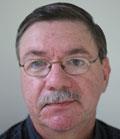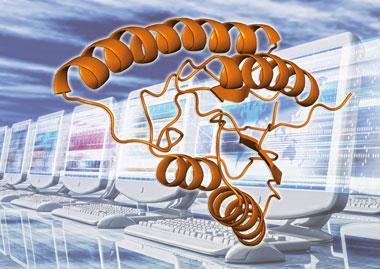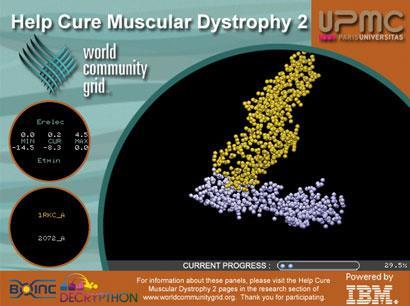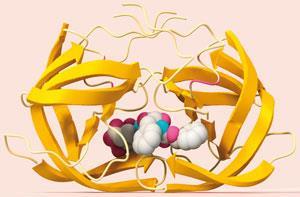Taking a coffee break could help find cures for cancer or Aids. Katrina Megget looks at the future of research that harnesses the computing power of the World Community Grid
Taking a coffee break could help find cures for cancer or Aids. Katrina Megget looks at the future of research that harnesses the computing power of the World Community Grid
It’s not every day that just twiddling your thumbs might solve some of humanity’s biggest health problems. But while you are off having your caffeine fix or gossiping over the water cooler, behind the scenes your computer could be helping to find the cure for cancer or Aids. In fact, 1.6 million personal computers in idle mode are currently chugging through a plethora of virtual simulations, from protein folding to drug-target interactions, as part of the world’s largest public humanitarian supercomputer known as the World Community Grid (WCG).

Now in its sixth year, the IBM initiative represents a network of individual computers belonging to 530,000 volunteers in more than 80 countries around the world. This ’grid’ works by harnessing an individual computer’s down time. Rather than an amusing animated screensaver, PCs run various computations using specially developed software. When completed, the results are sent back to the main server to provide scientists with research information in their quest for disease cures.

It might seem like a hands-off approach, but the beauty of the grid is the accelerated pace of research - what could take years in a costly time-consuming lab takes just months via the relatively inexpensive and eco-friendly World Community Grid. The grid receives seven computational results from volunteers’ PCs every second of the day. And when the number of computations performed by the grid each day is equivalent to one PC computing continuously for over 180 years, the genius of grid computing becomes apparent.
’There is strength in numbers - two heads are better than one,’ explains Joseph Jasinski, programme director of IBM’s Healthcare and Lifesciences Institute in Hawthorne, US. ’It’s like that with humans and the same holds true for computers.’
Together we’re stronger
Since their conception, computers have always had a strong role in research, performing complex algorithms and the like. However, it has only been in recent years that computing power has been granted to the average worker. This has led to a notable improvement in research - multiple processors can work together to perform computations at a faster pace. This allows them to cope with more sophisticated models and graphics-heavy simulations.

’Until grid technology came along, scientists tended to rely on stand-alone computers that were not connected to the outside world and to each other,’ says Jasinski. ’This began to change with the internet, where computational jobs could be controlled remotely or sent to a colleague. Then peer-to-peer networking, the falling cost of processors and the advent of multiprocessor PCs began to make grid computing feasible.’
In many ways the WCG is revolutionary, combining technology and the collective power of linked PCs with the spirit of community to provide cheap, speedy and promising results. But Jasinski denies it is a futurist technology, even though decades ago grid computing may have been envisioned as science fiction. ’The World Community Grid is a great example of how the world can be made smarter by pooling the goodwill, ideas and resources of people without demanding an excessive amount of money or time,’ he says. And when the world is faced with an ageing population, increasing chronic disease burden and poorly treated infectious diseases, time and money is of the essence in medical research.
This is exactly where the grid comes in. ’For example,’ says Jasinski, ’if we have a million molecules we want to test to see if they will be effective as new drugs, we need to do one computation for each molecule. If I only have one computer and each calculation takes one minute, it will take me a million minutes or about two years to complete my task. On the other hand, if I have one million computers I can complete the task in about one minute by having each computer perform one calculation.’
The reality of this is already evident. For the ’Help fight childhood cancer project,’ some 8000 years of research should be cut by using the grid, says Akira Nakagawara, president of the Chiba Cancer Centre at Chiba University in Japan. ’In the ordinary lab, it is absolutely impossible to do this kind of research,’ he notes. The project is screening three million small compounds against six targets in the hope of finding about 30 chemicals that could potentially treat the childhood cancer neuroblastoma. Already seven chemicals that specifically kill the neuroblastoma cells have been finalised for the first target.
Likewise, the separate ’Help conquer cancer’ project - which is analysing 86 million x-ray crystallography images to aid understanding of cancer-related proteins - has been able to dramatically slash research times. ’It is a long project even on the grid,’ says Igor Jurisica from the Ontario Cancer Institute in Canada. ’But without WCG we would not be able to make this comprehensive analysis in our lifetime.’ The computation helps the team to identify characteristic gene or protein expression ’signatures’ that can assist in diagnosing and monitoring diseases, or predicting how well patients will respond to certain treatments. Three of the lung cancer signatures are in preclinical stage already, while similar signatures in leukaemia, ovarian and head and neck cancer are in the pipeline.
Number crunchers
For Stan Watowich at the University of Texas Medical Branch in Galveston, US, doing research in this way is a no-brainer - particularly in disease areas considered high risk or financially unattractive. Watowich’s team is using the WCG to find treatment cures for dengue fever and West Nile virus and has been able to cut research times from an estimated 25 years on traditional laboratory multiprocessor computers to just weeks via the WCG.
In the first phase of the project, the team investigated about 15 different proteins that could be potential drug targets because of the role each plays in disease pathogenesis. Some 2.5 million small drug-like molecules were screened against these 15 proteins, resulting in over 35 million docking simulations. Now in the second phase, this number has been whittled down to 5000 promising candidate molecules and the team is running free energy calculations for each protein target. From these calculations, 50 of the best binding compounds for each target protein will be tested in biochemical assays to confirm the computer predictions. Active compounds will then be evaluated in cell culture assays and other preclinical tests with the ultimate goal of moving promising new drug candidates into clinical trials in humans with regulatory drug approval as the end result, says Watowich.
Not only does this research aim to attack the high attrition rate for compounds moving through the development process by providing more promising drug candidates that should have an improved probability of regulatory approval, Watowich says it also aims to show it is possible to accelerate drug discovery by completing accurate free energy of binding calculations on highly distributed computer resources. ’If successful, our grid-based drug discovery approach can be applied to almost any disease with defined molecular triggers,’ he adds.
The end of experiments?
So does this all point to grid-based computer simulations trumping traditional lab-based work? Jasinski says it is important to see the two as complementary. ’Today’s science demands both approaches. A computer can certainly offer certain efficiencies that reduce time and expense dramatically. At some point though, it becomes necessary to perform experiments with physical matter.’ Likewise, he says there are very few things in life that are infallible. While there are advantages to electronic simulations, they are, in the end, only as good as the accuracy of the computational model, he says. False positives do exist, and it requires additional research to eliminate these.

In the case of finding new drugs, Watowich adds that the candidates from grid-based research are really no different to leads that have entered the pipeline through more conventional paths. They will still require significant medicinal chemistry effort to be developed into drug candidates. However, he says, the greater number of grid-generated leads does mean an increased probability that at least one will become an approved treatment.
Modelling limitations aside, Jurisica believes that computation is going to ’revolutionise’ medicine. He points out that it was exactly this kind of ’brute force computing’ that enabled the identification of thousands of prognostic signatures in lung cancer. Indeed, this success has led to Jurisica’s team preparing a new WCG proposal where the main idea is to combine the knowledge of physical protein interactions, protein disorder and other properties with failed crystallisations to predict co-crystallisation experiments.
Tackling the hardest problems
Watowich points out that drug discovery projects for any number of neglected, rare and infectious diseases are effectively endless. ’The computing power of the World Community Grid will allow researchers to think beyond the confines of traditional computing and launch large computing efforts that accurately model physical processes.’ He adds that ’the relatively low cost of the WCG makes it ideal for studying diseases that do not appear to offer an attractive return on investment to large pharmaceutical companies’.
Not only is the WCG an ’incredible resource’ for researchers who may have no other means to test their ideas, notes Jasinski, it is also a starting block for attacking diseases that have been traditionally hard-placed to treat. One such disease is Aids. According to the Global Health Council, in 2008, 33.4 million people around the world were living with HIV and 2.7 million people were newly infected with the virus. While the disease can be treated with drugs, there is no cure. But perhaps more problematic, is that the virus, often called a ’sloppy copier’, is constantly evolving new variants leading to drug resistance.

Arthur Olson, from the Department of Molecular Biology at The Scripps Research Institute in La Jolla, US, is using the World Community Grid to address this issue. ’From a medical point of view, evolution of resistance in HIV infected patients is a major threat to their continued survival. Our approach is to understand the mechanisms of viral resistance and to develop therapeutics that can box the virus into a corner from which it cannot escape.’ The team is screening more than 300,000 molecules against multiple variations of two target sites on the HIV protease, which is involved with virus maturation. ’Typically we hope to whittle this number down to 30 or 40 compounds that we can then order and hand on to our collaborators to test experimentally,’ he says.
Wide open possibilities
The future of research using the WCG isn’t just about seeing how proteins interact with other molecules. At New York University, US, Richard Bonneau is using the WCG to predict how proteins fold. Taking the collection of microbes found inside and on the skin of humans, the team is looking at whether proteins derived from the genes of these organisms - many of which have gene sequences not seen before - perform novel functions or if their resulting protein structure is similar to known structures. ’Using the WCG, we can start to answer some of these questions and maybe uncover new enzymes or protein scaffolds while trying to understand the full extent of protein fold space,’ says Kevin Drew, a doctoral student in Bonneau’s team. Normally, this would be a costly and time consuming exercise but the WCG can help push findings into the lab, he says. To date, proteins translated from more than 94 genomes have been folded in this project.
Indeed, genomes and DNA are expected to play an expanding role in future grid research. Already, Olson and his team are beginning to use patient data to understand the individual variation in response to various HIV therapy regimes - a step, he says, towards more personalised treatments. Nakagawara agrees, saying the grid can be used for more personalised projects like genomics screening or signalling pathway analysis - both of which could play a role in next generation cancer treatments. ’The WCG can be applied to analyse the huge data sets obtained from DNA sequencing, transcriptome, proteomics and chemical structures to make personalised medicine possible.’
But this is just the tip of the iceberg when it comes to the grid’s future research potential, says Jasinski. As long as the computational models are in place ’there is no real limit to the kinds of research areas the grid can contribute to’. Already the grid has been used to investigate environmental chemistry, how to produce more nutritious food and how to manage natural water courses for maximum benefit. But, says Jasinski, ’we also believe the grid can help in weather and climate models and in studies of topics in social sciences and humanities - such as comparative studies of literature, language, music. We are not limited to the physical sciences,’ he says. ’We are only limited by the creativity of different research communities in their ability to create accurate computational models.’ Idle or not, what better excuse is there to take that lunch break?
Katrina Megget is a freelance science writer based in London, UK






No comments yet